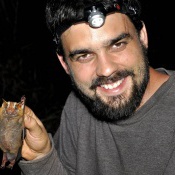CrypDiv Unveiling bat cryptic divergence in Iberia: using distribution modelling and genetic analyses to investigate the isolation and differentiation of species
Considering the lack of knowledge and species threat level, this work will be mainly aimed to the capture/detection of Barbastella barbastellus. This species has the status of "Indeterminate” on the Portuguese Red Book (SNPRCN 1990) and it is considered "Vulnerable” at a global scale by the IUCN. Furthermore, captures/detections of other tree-dwelling species are also expected. Data from these species will also be analysed whenever sample sizes permit. The distribution of the focal species and the identification of limiting factors to their presence, together with the genetic analysis of their population structure may allow identifying key areas for the conservation of the group. Bats are protected under European legislation on the Conservation of Natural Habitats and of Wild Fauna and Flora. Barbastelles are listed under Annex II of this directive, requiring that Special Areas of Conservation (SACs) be designated for their protection. This research would assist in identifying potential SACs. The study on roost selection is the base for the future development of artificial roosts, thus minimizing the impact of roost number reduction due to human activities. Therefore the proposed objectives are:
1 – To investigate and improve current methodologies of trapping bats in Europe. This will consist on developing artificial lures that could increase the efficiency of mistnetting and on testing the use of distress calls playbacks to attract bats.
2 – To develop habitat-suitability models for the focal species and to determine which ecogeographical variables influence their distribution.
3 – To investigate the genetic structure of the populations by measuring the levels of gene flow among sampled populations.
4 – To describe roost characteristics, namely morphology, thermal behaviour and localization, in order to determine optimal roost conditions. Trees in the vicinity of occupied roosts will also be measured to determine if there is selection.
Gareth Jones, Jorge Manuel Mestre Marques Palmeirim, Javier Juste Ballesta


